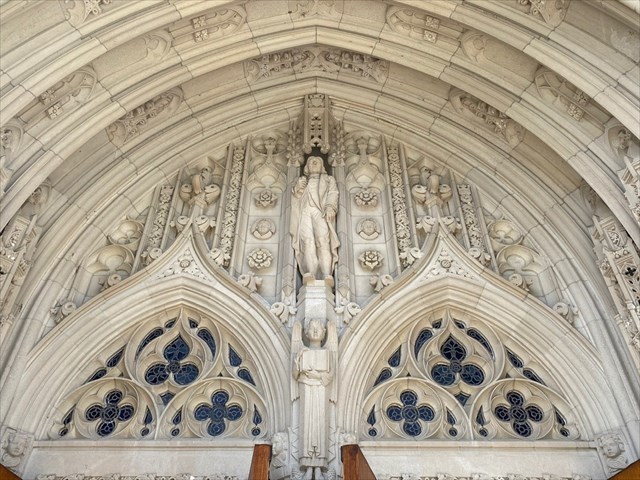Earthcaches have no "box" to find. Rather, with this earthcache, you discover something about geology. For more information, see earthcache.org.
Parking at Duke can be tricky, especially on weekdays. The pay parking garage that serves Duke Chapel is at 125 Science Drive near the Bryan Center.
With this earthcache, you will learn about Indiana limestone and how it was used in the construction of the Duke Chapel.

When Duke University’s West Campus was built, each laborer was assigned a level of work. Stonemasons worked with the Duke Stone. Only the very best laborers were selected for the more delicate work with the cutstone (Indiana limestone). These stone setters dealt with the arches and doorways throughout the campus, and hand-carving Duke Chapel's archways, sculptures, and all its lines of detail. Working under the supervision of Scotsman Donald Macadie, the stonecutters were nearly all Italian and had completed stonemason apprenticeships while living in Europe.

Duke University in pieces. University Archives Photograph Collection. Duke University Archives, Durham, NC.

Stonecarver John Ribet and supervisor Donald Macadie place a spire on the Chapel. "Image 1." Prevatt/Stewman. Box 086. University Archives Photograph Collection. Duke University Archives, Durham, NC.
Indiana limestone (a common regional term for Salem limestone) is a geological formation primarily quarried in south central Indiana, between the cities of Bloomington and Bedford.
Indiana limestone is a rock primarily formed of calcium carbonate. The limestone was deposited as marine fossils that decomposed at the bottom of a shallow inland sea which covered most of the present-day Midwestern United States during the Mississippian period.
At that time, most of the land mass now known as North America lay south of the equator. Shallow, clear water covered the area that stretches from present-day Nebraska to Pennsylvania. A myriad of organisms swam and crawled about this placid sea. When they died, their bodies settled to the sea floor, over time solidifying into a 90-foot-thick stone menagerie. This homogeneous matrix of corpses formed a rock that cuts cleanly and evenly in all directions.
Wave action from long-still tides shattered most of the fossil's shells, but many organisms persist and stand out. A unicellular animal known as a foraminifer, which lived in the ooze and muck of the sea floor, is common in this limestone but hard to see, even with magnification. Dotted throughout the walls, and easily discernible, are the poker-chip-shaped stems of crinoids, an extinct relative of starfish, and half-inch-long bryozoans, a sedentary animal that formed colonies of Lilliputian-scaled apartment complexes patterned like Rice Chex cereal. Many shell fragments come from pelecypods, the group that includes oysters, clams, and scallops. A rare find is a perfectly formed half-inch-long snail shell, which resembles a tiny swirled dunce cap.
The limestone is soft and is easily worked when it is quarried, but once the quarried rock dries it becomes case-hardened, that is, its surface becomes harder and more resistant to weathering. When quarried, the limestone is light-grey to bluish-grey (calcarenite) that typically oxidizes to a light tan. Indiana limestone is a freestone, which means that it has no preferential direction of splitting. It can be planed, turned on a lathe, sawed, and hand worked, making it highly versatile.
Indiana limestone is chemically pure and consistent, being composed of 97% calcite. The combination of these physical and chemical characteristics makes Indiana limestone well suited to building because of the following:
- It is more durable than a typical limestone.
- It can be cut into very large blocks.
- It can hold fine detail when carved.
Logging Tasks: (Required)
Please send your answers via geocaching message center (preferred) or email.
- Rub your hand over the Limestone facing. Is it extremely rough, rough, smooth, or polished?
- Do you see any fossils in the limestone?
- Why do you think Indiana limestone was used for this building?
- Do the carvings show any type of erosion?
- Please post a picture in your found it log of you/part of you/your avatar with your favorite limestone feature.
References